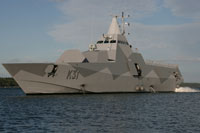
|
||
|
VISBY CLASS |
||||||||||||||||||||||||
|
The Visby Class of stealth corvettes is being built for the Swedish Navy by the Swedish company Kockums. The first ship in the class is named after Visby, the main city on the island of Gotland.
The design of the Visby has been directed to minimising the optical and infrared signature, above water acoustic and hydroacoustic signature, underwater electrical potential and magnetic signature, pressure signature, radar cross section and actively emitted signals
The corvettes will be equipped with eight Saab Bofors Dynamics RBS 15 mk2 anti-ship missiles. Mk3 anti-ship missiles. The RBS 15 mk3 uses active Ku-band radar homing and has a range of more than 200km. The missile has a high subsonic speed, Mach 0.9, and is armed with a 200kg warhead. The missiles will be installed below deck and be fired through special hatches to maintain the vessel's stealth. The missiles' exhaust plumes will be managed in separate canals.
The Visby is powered by a combined diesel and gas (CODAG) turbine arrangement. Four TF 50 A gas turbines from Honeywell and two MTU 16V 2000 N90 diesel motors are connected to two gearboxes which run two Kamewa waterjet propulsors.
|
||||||||||||||||||||||||
